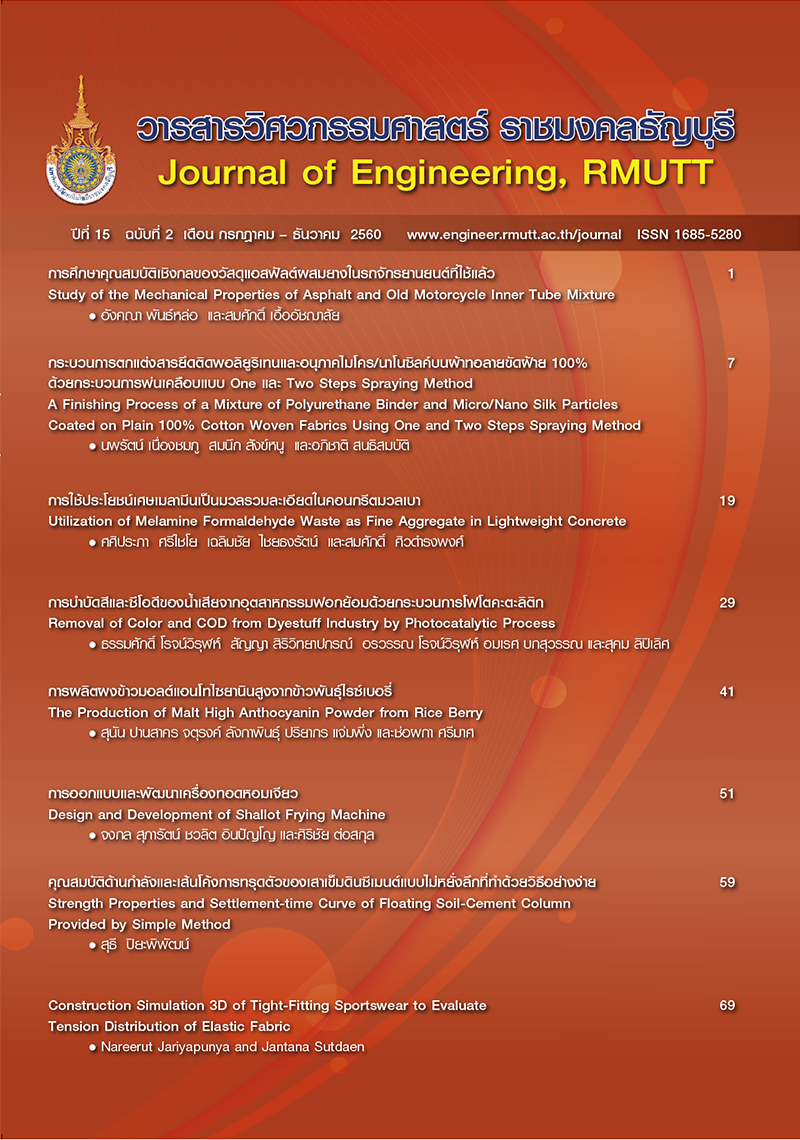Utilization of Melamine Formaldehyde Waste as Fine Aggregate in Lightweight Concrete
Main Article Content
Abstract
This paper presents utilization of melamine formaldehyde waste from Tableware industry. The melamine waste was used to replace sand in lightweight concrete as aggregates by 25 wt%. The melamine waste was in the form of granule and powder, mixing ratio between melamine waste granule to powder were 100:0, 90:10, 85:15, 75:25, 50:50 and 0:100. Concrete sample was prepared with water to cement ratio of 0.5 and the density of lightweight concrete are 1,100 kg/m3 and 1,300 kg/m3. The samples of lightweight concrete, at curing age 28 days, were tested for compressive strength, water absorption and thermal conductivity. From the testing results of lightweight concrete containing melamine waste compared with reference lightweight concrete, it was found that, the compressive strength was increased. It could be considered due to better gradation of aggregate, angular shape and rough texture of melamine. Water absorption was also increased which is due to the melamine waste has higher water absorption than sand. Thermal conductivity was slightly increased, it might be discussed from more compacted of concrete containing melamine waste. The sample with 10% of melamine powder (MFGP90:10) was conform to Thai Industrial Standard (TIS 2601-2556) in term of compressive strength and water absorption. This results yielded the opportunity to utilize melamine waste granule together with melamine waste powder. Therefore, it could be concluded that the melamine waste could be used to replace sand to produce lightweight concrete, which not only improves the strength of lightweight concrete but also reduces the use of natural resources (sand).It could also takes advantage of melamine waste by recycling and can be developed for commercial production of lightweight concrete in the future.
Article Details
The manuscript, information, content, picture and so forth which were published on Frontiers in engineering innovation research has been a copyright of this journal only. There is not allow anyone or any organize to duplicate all content or some document for unethical publication.
References
Siwadamrongpong S. & Aphirakmethawong, J., (2015). Effect of Particle Size and Content of Waste Melamine Formaldehyde on Mechanical Properties of High Density Polyethylene Composites. In The 9th South East Asian Technical University Consortium (SEATUC). Suranaree University of Technology, 27-30 July 2015 Surasammanakarn
Hasan S. Dweik, Mohamed M. Ziara and Mohamed S. Hadidoun, (2008). Enhancing Concrete Strength and Thermal Insulation Using Thermoset Plastic Waste. International Journal of Polymeric Materials and Polymeric Biomaterials Volume 57,635-656
C. Albano, N. Camacho, M. Hernández, A. Matheus, A. Gutiérrez, (2009). Influence of content and particle size of waste pet bottles on concrete behavior at different w/c ratios. Waste Management 29, 2707-2716.
Semiha AkÇaözoğlu, Cengiz Duran Atiş, Kubilay AkÇaözoğlu, (2010). An investigation on the use of shredded waste PET bottles as aggregate in lightweight concrete. Waste management 30, 285-290.
Amir M. Azhdarpour, Mohammed R. Nikoudel, Milad Taheri., (2016). The effect of using polyethylene terephthalate particles on physical and strength-related properties of concrete; a laboratory evaluation. Construction and Building Material 109, 55-62.
Phaiboon P., Mallika P., (2007). Reuse of thermosetting plastic waste for lightweight concrete. Waste Management 28, 1581-1588.
Khamphee J., Theerawat S., Prinya C., (2011). Cellular Lightweight Concrete Containing Pozzolan Materials. Procedia Engineering 14, 1157–1164.
Chaitongrat, C. & Siwadamrongpong, S. (2018). Recycling of melamine formaldehyde waste as fine aggregate in lightweight concrete. Songklanakarin Journal of Science and Technology Vol. 40 No. 1 (January-February, 2018). IN PRESS


